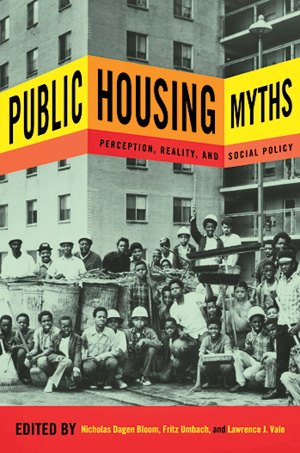Nothing led to the disillusion with modern architecture during the postmodern era more than the critique of public housing. It was not, after all, Robert Venturi's Complexity and Contradiction in Architecture (1966) that really ushered in the new style. That book was too complex and subtle. Charles Jencks's more colorful and bombastic The Language of Postmodern Architecture (1977) was much more influential, and it began with a view of the destruction of Pruitt-Igoe. With one facile fell swoop, both modernist form and modernist idealism were imploded.
Oscar Newman's Defensible Space (1972) also played a role. “It is the apartment tower itself which is the real and final villain,” Newman wrote.
But, as several studies in the new book Public Housing Myths show, the problem was not the high-rise so much as well-intentioned social policy. Projects, particularly in Chicago, gave priority to large families that had trouble finding market-rate housing. Reformers assumed that children, in particular, would benefit from modern housing. But buildings with a higher percentage of children than adults—an imbalance the authors call “youth density”—ended up having much higher crime rates, even though, initially at least, the tenants were stable two-parent families. Eventually, these complexes became unmanageable. Another seemingly logical policy—setting rents at a percentage of income— ended up driving out the working poor. When they were replaced by the nonworking poor, housing authorities ended up with less money for maintenance.
The editors of this book—and the authors of most of its essays—are professors who study and teach architecture, planning, or history, though one piece is by Yonah Freemark, a project manager at Chicago's Metropolitan Planning Council. The book shows—in careful study after careful study—that the critique of public housing was inaccurate, misfocused, and often even fabricated. Most public housing thrived, but the projects that failed got much more publicity.
Among the authors' findings are that the serious problems attributed to modern housing projects throughout the nation were, in fact, in a very few places. The largest concentration of high-rise public housing in the nation—in New York—has been surprisingly successful, because of good management and the fact that, in New York, high-rise housing is the norm.
Also, although modernist tower blocks are synonymous with public housing in the American imagination, only a third of public-housing units are actually in high-rises. And the most troubled complexes have been in cities that were losing population, jobs, and other opportunities: housing was part of a much larger problem.
The myths are debunked in chapters including “Modernist Architecture Failed Public Housing,” “Public Housing Breeds Crime,” “Public Housing Ended in Failure in the 1970s,” “Mixed-Income Redevelopment Is the Only Way to Fix Failed Public Housing,” and “Public Housing Is Only for Poor People.”
This book appears at a time when many cities have an inadequate supply of affordable housing. There are plenty of problems in need of solutions, and these studies—taken together—should go some distance in finding the right ways to solve them.

